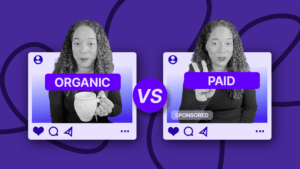21 Essential UGC Facts: Boosting Engagement, Trust, and Brand Visibility in Digital Marketing
With over 7 years of e-commerce experience, Agne has mastered the balance of creativity and performance. From guiding social media strategies to crafting high-converting ads, she’s all about results.

User-generated content (UGC) is taking the world by storm. Brands know that offering their customers the authentic opinions of their peers is a surefire way to stand out in the marketplace.
But how can you quantify the success and impact of UGC? Well, we’re about to make it easy. The following list provides detailed facts and information about the value of user-generated content and how it is impacting different industries. It covers everything, from marketers’ opinions on the movement to its effectiveness compared to conventional advertising.
So, whether you are considering leveraging UGC content in your brand or want to justify ongoing efforts, this article is for you. Read on to learn more about the effectiveness and reach of user-generated content with these UGC facts. .
1. 67% of retailers want to increase investment in UGC [1]
This fact reveals the extent to which retail companies and ecommerce stores understand the benefits UGC offers in the online environment. Companies know that user-generated content offers superior social proof, enabling them to sell more products.
Furthermore, most shoppers want to consume UGC before hitting the buy button. Seeing genuine and authentic reviews, how-tos, and hype pieces helps them feel more confident about spending hard-earned cash.
2. 40% of customers made a purchase after seeing UGC on social media [2]
UGC is also a powerful tool for promoting purchases, as is clear from this statistic. For many consumers, the content is the final step along the sales funnel before conversion.
Again, UGC is effective in making conversions because it builds trust. Consumers are far more likely to take what their peers say seriously than brands using slick marketing campaigns.
Furthermore, many companies are now including shoppable links in branded content, including on Facebook, Instagram, Pinterest, TikTok, YouTube, and Snapchat. These allow users to buy products without leaving the content platform at all, encouraging more pro-purchase behavior.
3. 98% of customers read user reviews of local businesses online [3]
This astounding statistic reveals that nearly everyone in today’s marketplace reads online reviews for companies they want to use in their local area. The high figure is a reflection of the fact that many of these firms aren’t well-known brands and can’t always generate trust through familiarity..
Reviews are critical in this context because they show the average experience of customers at the firm. Most consumers will consider buying from a firm if its score is higher than 4 stars and will almost certainly use it if it is above 4.5 stars (out of 5).
4. Users post over 1 billion reviews online about companies every year [4]
In another unbelievable fact, internet users post something like 1 billion reviews online every year, reflecting a general willingness to share their experiences with other users. These provide valuable insights for anyone wanting to learn more about products/services and make an informed purchasing decision.
Most of these reviews appear on public platforms, like Google and Facebook. These are free and help with SEO and within-platform visibility.
Others, like TrustPilot, require signing up to a paid subscription, which is significantly more expensive. However, their oversight tends to be better and the public often trusts them more.
5. The UGC content market is now worth more than $5.36 billion [5]
The size of the user-generated content market is also growing rapidly, reflecting massive interest from corporate brands. Companies know that if they leverage this type of content on social media, they can access a broader audience. Furthermore, the level of investment in UGC is set to grow further. Industry research suggests that it could balloon six-fold and be worth over $32.6 billion by 2030.
6. 77% of consumers are willing to submit UGC if it means they have a chance of winning a reward [1]
While many users will write reviews for free, this statistic demonstrates a widespread willingness to engage fully in UGC if there is an incentive. For many firms, this means entering consumers into a prize draw of some description. However, it can also include providing behind-the-scenes access to company operations (helpful for content creators), sending free products, or providing salaries to brand ambassadors.
7. 31% of shoppers find UGC ads more memorable than their conventional counterparts [2]
This fact shows that UGC advertisements stick in the minds of consumers and that brands don’t have to focus on organic content exclusively. Many shoppers prefer UGC ads because they offer a personal connection to the content creator. Often, this person understands their pain points and can help them work through the challenges they face.
8. 25% of organic search results for large companies come from UGC [6]
Research suggests that multinationals and other billion-dollar companies can benefit from UGC, too, meaning it isn’t only for small companies. Campaigns build support at the grass roots level and introduce new audiences to their products and services in an engaging and unique way.
Many of the largest brands work with hundreds or thousands of influencers to get their message out using convenient platforms, like Billo. And some, like Gymshark, built their entire businesses on UGC, using it to showcase their products.
9. 85% of consumers say UGC is more influential than brand photos and videos [5]
This incredible statistic reveals the power of UGC in helping brands communicate with their audiences. It suggests that companies are more likely to thrive if they work with influencers or creators than leveraging in-house or third-party marketing teams.
Again, the success of UGC in this context likely comes from its ability to generate authenticity and trust. Consumers believe what their peers say more than brands with a vested interest in selling to them.
10. 21% trust high-quality reviews the most, followed by other factors, like star-rating [7]
Industry research shows that shoppers care most about the quality of reviews, followed by other factors. Twenty-one percent say in-depth testimonials are the most influential when making purchasing decisions, followed by 19 percent who say the star rating matters most, and 13% who say it is the number of reviews that counts. These UGC facts suggest that companies should focus on providing detailed product/service UGC in review format by working with the right creators.
11. 80% of Gen Z consumers have or want to share their purchase decisions online [8]
Further data also reveals that Gen Z consumers – the youngest valuable cohort for marketers – are willing to create UGC without incentives. Most said they already shared content online, with a significant proportion also confirming they would be willing to do so if given the chance.
This communitarian attitude is surprising and welcome by marketers. Gen Z shoppers want to spread news about high-quality brands to their peers to help them with their consumption decisions.
12. 35% of Gen Z believes UGC will be more credible than branded content in the next 3 to 5 years [2]
This statistic reflects the growing trust and belief in UGC’s bright future. Gen Z understands that the credibility and trust it generates goes beyond conventional advertising methods.
UGC’s growing credibility emerges from its increasing universality. Internet users can now find it everywhere, propelling it into mainstream acceptance.
13. Consumers spend 5.4 hours online every day consuming UGC [3]
The amount of time shoppers spend online suggests that UGC still has room to grow. Consumers are providing online social media channels with more attention than ever before, allowing companies to reach them through increasing UGC content.
Shoppers are also enjoying social media content more because of the improving quality of the content it offers. Platforms are moving away from low-quality bulk productions and toward more focused and compelling shorts.
14. 64% of young adults (aged 18 to 44) say they would be more loyal to a brand if it used their UGC in its marketing [5]
This fact is even more interesting and suggests that it may be possible for companies to build alliances with their audiences by using their UGC proactively. Gymshark, RedBull, and Warby Parker are highly successful firms who seem to know this already!
The strategy of using customer UGC in ads works because it aligns shoppers with brands. Consumers feel like they are contributing to their success and a part of their wider story, encouraging them to spend more.
15. UGC engagement is higher on some platforms than others [9]
The top platform for high-performing UGC content is Facebook at 23%, followed by TikTok at 19%, YouTube at 17% and X at 10%. As such, brands may want to skew their outreach efforts accordingly. Generally speaking, the platforms most conducive to video content seem to be the most successful.
16. 34% of consumers say that brands that self-promote excessively puts them off [10]
This fact reveals how most consumers want to see more authentic content on their social media channels. Excessive self-promotion is a turn-off for many shoppers who would rather products and services speak for themselves.
Fortunately, brands can self-promote using UGC creators on Billo. These individuals create content independently according to your brief, prioritizing honestly and transparently that reflects your brand.
17. 81% of marketers believe visual content is the most effective form of UGC [9]
Nearly four fifths of marketing professionals believe UGC is more effective in reaching shoppers than conventional commercial photography or video production. Furthermore, many believe it is more compelling than traditional influencer content.
This statistic reveals what many in the industry have known for a long time: getting shoppers themselves to create content is often the most effective policy. Consumers view it as wholly authentic and representative of brand experiences.
18. 16% of brands have a UGC strategy [2]
Relatively few companies have a detailed plan covering how they will use user-generated content to drive sales and conversions. Many adopt an ad hoc approach, while some ignore the opportunity entirely.
The fact so few brands are leveraging UGC to the maximum extent is a reflection of the novelty of the marketing method. While various forms of user-generated content marketing have been around since the dawn of the internet, the marketing profession is yet to jump on the opportunity en masse.
19. UGC ads’ clickthrough rate is four times higher than conventional PPC [11]
UGC ads tend to achieve far higher CTRs than conventional digital and ecommerce marketing methods, including copy-optimized pay-per-click (PPC) ads. Furthermore, data suggest that cost-per-click (CTC) is more than 50% lower than via standard methods, when taking into account the price of paying platforms for advertising and the cost of arranging user PPC.
Researchers believe this higher rate arises from the phenomenon of ad fatigue. Most internet users now instinctively skip banner ads and pop-ups without even looking at what they contain. The opposite is true for UGC..
20. Millennials trust UGC content 50% more than conventional content [12]
Millennials were perhaps the first highly sophisticated internet generation to look upon ads differently. Most consumers in this age group have a cynical attitude toward corporate outreach, with many installing ad blockers on their devices or ignoring it entirely.
That’s why this statistic is so critical. It shows that millennials – adults born in the years running up to the turn of the millennium – are far more trusting of UGC than other forms of online content. Moreover, it now matters more than ever since research predicts this age bracket will have the highest purchasing power in history in the next decade.
21. People over 25 create 70% of UGC [13]
Finally, if you thought creating UGC was a young person’s game, think again. Data show that older age groups generate the majority of content.
The reason for this has to do with the prosocial behavior of many older users. Some see it as their duty to inform the community about their experience with brands’ products and services. Others simply have more time on their hands, or use product-related UGC as a vehicle to discuss their hobbies and interests.
Sources:
Creative Manager
With over 7 years of e-commerce experience, Agne has mastered the balance of creativity and performance. From guiding social media strategies to crafting high-converting ads, she’s all about results.

Authentic creator videos, powered by real performance data
22,000+ brands use Billo to turn UGC into high-ROAS video ads.
Common UGC Brief Mistakes Brands Still Make in...
A vague or overpacked brief derails campaigns before they start, [...]...
Read full articleOrganic UGC vs Paid UGC: How Top Brands Drive Gr...
More brands are turning to user-generated content (UGC) to fuel [...]...
Read full articleOrganic UGC: How to Turn Native Creator Posts in...
Short-form feeds spotlight content that feels natural, not like ads. [...]...
Read full article



